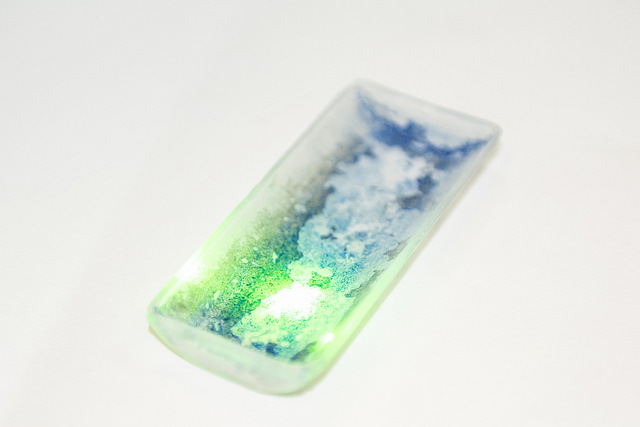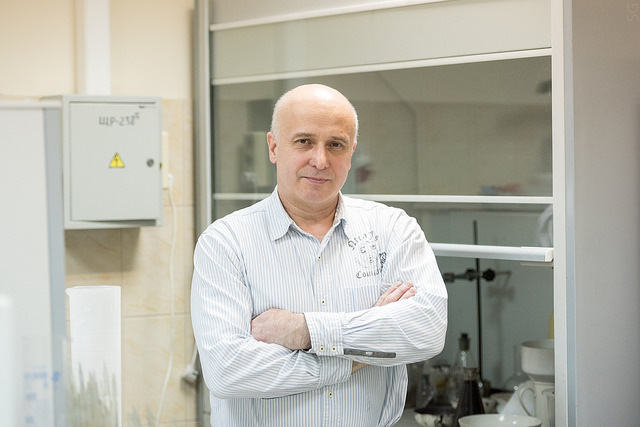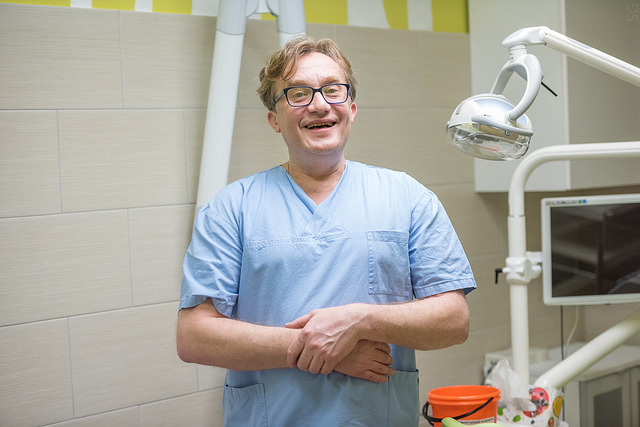New generation dental materials prevent secondary caries or “Eternal” fillings
Scientists of NUST “MISiS” created a technique that can become the basis of a fundamentally new method of antibacterial therapy. She has wide prospects for use in dentistry, maxillofacial surgery, treatment of ENT diseases and other medical fields. The created nanoparticles of iron, zinc, titanium and other metal oxides in dental materials have a unique property - they work as antibiotics without side effects.

The basis of the proposed development are liquid colloidal systems synthesized at NUST “MISiS” (ultra-thin suspensions that do not precipitate), consisting of high-energy nanoparticles of iron, zinc, titanium and other metals, ranging in size from 1 to 3 nm.
The main problems that dentists face when installing fillings are the active formation of colonies of pathogenic bacteria at the junction of the filling material and dentin (tooth tissue under the enamel) of the tooth, as well as the formation of microcracks and microcavities during technical shrinkage of the fillings. A phenomenon known to many patients - a seal falls out after a few years, and under it there is an even greater caries lesion than before treatment. Even if all technological procedures are followed, a micro gap forms over time at the border of the seal, where microorganisms actively multiply. A complicating factor is that the dentin of the tooth is a hydrophilic (water-wetting) material, and the filling, on the contrary, consists of hydrophobic (water-repellent) substances.

Nanomaterial that protects fillings from caries.
The studies conducted by the scientific group showed that despite the ultra-low concentrations of metals contained in disperse systems - not more than 0.1 mg / l, i.e. 10-7 g per 1 liter of water - they have a long-term bactericidal effect in relation to microflora responsible for the development caries. Such nanoadditives can give prolonged antiseptic properties to dental materials used in the preparation and installation of fillings. The task of these materials is to ensure good bonding (adhesion) of the filling material and tissue of the restored tooth. The presence of colloidal particles of metals and metal oxides in their composition improves adhesion, significantly reduces the shrinkage of the seal during curing, and at the same time prevents the appearance and reproduction of pathogenic microbes that cause caries,
In medicine, the challenge today is to search for fundamentally new drugs with high antibacterial activity, which would reduce the resistance (resistance) of pathogenic microorganisms in relation to natural and medicinal antibiotics. "We assume that the mechanism of destruction of the microbial cell under the action of the colloidal nanosystems we have created resembles the action of antibacterial enzymes of the hydrolase class, which destroy the walls of bacteria by hydrolysis. Such enzymes in relatively high concentrations are found in places where the body contacts the environment - saliva, nasopharynx and gastrointestinal mucus, and breast milk. Their action leads to the process of lysis (destruction of cells into fragments) and the death of a pathogenic cell. Apparently, metal oxide nanoparticles act as a hydrolase catalyst, which ultimately leads to the destruction of peptide and glycosidic bonds of cell walls and membranes. Under their action, the mechanism of “self-destruction” of pathogenic bacteria is activated.", - said the head of the scientific group, associate professor of the Department of Physical Chemistry of NUST" MISiS "Georgy Frolov .

George Frolov
The obtained nanoparticles in dental materials have a unique property - they work as antibiotics, but without side effects, that is, they suppress the development of pathogenic microorganisms, and, as the studies show, in most cases they do not inhibit the vital activity of natural microflora, and do not affect the cells of the body tissue . In the material received, the scientific team solved the long-standing problem of "spending" the antibacterial composition, which enters into a chemical reaction and is actually wasted, but it is impossible to add it to a sealed tooth. The new composition works all the time the fillings are in the tooth, which is a serious advantage.
"The development of scientists of NUST “MISiS” is essentially a technological revolution in dentistry, as it represents dental composites of a new, sixth generation. At the phase separation boundary, this material creates an unlimited bactericidal effect, and improves the adhesive “adhesion” of the filling to tooth tissue by more than 40%. The antibacterial additive can be used not only as a part of a filling, but also in an adhesive, in composites, etching materials, interlayers, implants and in compositions for sealing tooth fissures. In all formats, it creates a surface and volumetric antibacterial effect in the operated areas and ultimately extends the life of fillings and implants. In our clinic, the drug has been successfully used since September 2016, ”said the project participant,head doctor of the clinic "Rosdent", Ph.D. Jacob Karasenkov .

Yakov Karasenkov
Comprehensive studies launched in 2014 are an example of an effective public-private partnership in the implementation of new innovative technologies. The main customer and co-investor of the development was one of the largest domestic manufacturers of dental materials LLC StomaDent, which currently produces innovative dental composites based on developed drugs. Composite filling nano-hybrid material was registered by Roszdravnadzor in 2016. The co-investor of the project was the Ministry of Education and Science of the Russian Federation, which funded 50% of the cost of exploratory research in the framework of the Federal Target Program "Research and Development in Priority Directions for the Development of the Research Complex of the Russian Federation."

The basis of the proposed development are liquid colloidal systems synthesized at NUST “MISiS” (ultra-thin suspensions that do not precipitate), consisting of high-energy nanoparticles of iron, zinc, titanium and other metals, ranging in size from 1 to 3 nm.
The main problems that dentists face when installing fillings are the active formation of colonies of pathogenic bacteria at the junction of the filling material and dentin (tooth tissue under the enamel) of the tooth, as well as the formation of microcracks and microcavities during technical shrinkage of the fillings. A phenomenon known to many patients - a seal falls out after a few years, and under it there is an even greater caries lesion than before treatment. Even if all technological procedures are followed, a micro gap forms over time at the border of the seal, where microorganisms actively multiply. A complicating factor is that the dentin of the tooth is a hydrophilic (water-wetting) material, and the filling, on the contrary, consists of hydrophobic (water-repellent) substances.

Nanomaterial that protects fillings from caries.
The studies conducted by the scientific group showed that despite the ultra-low concentrations of metals contained in disperse systems - not more than 0.1 mg / l, i.e. 10-7 g per 1 liter of water - they have a long-term bactericidal effect in relation to microflora responsible for the development caries. Such nanoadditives can give prolonged antiseptic properties to dental materials used in the preparation and installation of fillings. The task of these materials is to ensure good bonding (adhesion) of the filling material and tissue of the restored tooth. The presence of colloidal particles of metals and metal oxides in their composition improves adhesion, significantly reduces the shrinkage of the seal during curing, and at the same time prevents the appearance and reproduction of pathogenic microbes that cause caries,
In medicine, the challenge today is to search for fundamentally new drugs with high antibacterial activity, which would reduce the resistance (resistance) of pathogenic microorganisms in relation to natural and medicinal antibiotics. "We assume that the mechanism of destruction of the microbial cell under the action of the colloidal nanosystems we have created resembles the action of antibacterial enzymes of the hydrolase class, which destroy the walls of bacteria by hydrolysis. Such enzymes in relatively high concentrations are found in places where the body contacts the environment - saliva, nasopharynx and gastrointestinal mucus, and breast milk. Their action leads to the process of lysis (destruction of cells into fragments) and the death of a pathogenic cell. Apparently, metal oxide nanoparticles act as a hydrolase catalyst, which ultimately leads to the destruction of peptide and glycosidic bonds of cell walls and membranes. Under their action, the mechanism of “self-destruction” of pathogenic bacteria is activated.", - said the head of the scientific group, associate professor of the Department of Physical Chemistry of NUST" MISiS "Georgy Frolov .

George Frolov
The obtained nanoparticles in dental materials have a unique property - they work as antibiotics, but without side effects, that is, they suppress the development of pathogenic microorganisms, and, as the studies show, in most cases they do not inhibit the vital activity of natural microflora, and do not affect the cells of the body tissue . In the material received, the scientific team solved the long-standing problem of "spending" the antibacterial composition, which enters into a chemical reaction and is actually wasted, but it is impossible to add it to a sealed tooth. The new composition works all the time the fillings are in the tooth, which is a serious advantage.
"The development of scientists of NUST “MISiS” is essentially a technological revolution in dentistry, as it represents dental composites of a new, sixth generation. At the phase separation boundary, this material creates an unlimited bactericidal effect, and improves the adhesive “adhesion” of the filling to tooth tissue by more than 40%. The antibacterial additive can be used not only as a part of a filling, but also in an adhesive, in composites, etching materials, interlayers, implants and in compositions for sealing tooth fissures. In all formats, it creates a surface and volumetric antibacterial effect in the operated areas and ultimately extends the life of fillings and implants. In our clinic, the drug has been successfully used since September 2016, ”said the project participant,head doctor of the clinic "Rosdent", Ph.D. Jacob Karasenkov .

Yakov Karasenkov
Comprehensive studies launched in 2014 are an example of an effective public-private partnership in the implementation of new innovative technologies. The main customer and co-investor of the development was one of the largest domestic manufacturers of dental materials LLC StomaDent, which currently produces innovative dental composites based on developed drugs. Composite filling nano-hybrid material was registered by Roszdravnadzor in 2016. The co-investor of the project was the Ministry of Education and Science of the Russian Federation, which funded 50% of the cost of exploratory research in the framework of the Federal Target Program "Research and Development in Priority Directions for the Development of the Research Complex of the Russian Federation."
